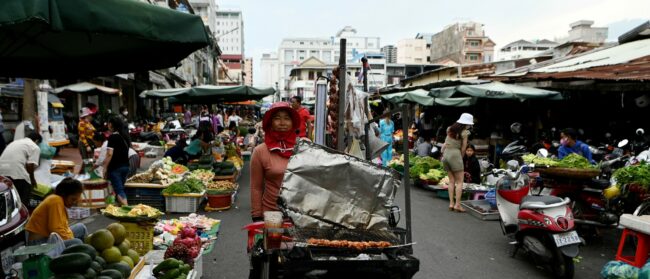It is lunchtime on Koh Pich, a manmade island in Phnom Penh that will one day host the country’s finest condo developments and a host of other attractions. For now, skyscrapers at various stages of completion dominate the landscape.
Sakon is a 55-year-old construction worker, who prefers not to reveal his full name. He sits shirtless on top of the thin mat that he will sleep on later that night. Sakon lives and works inside what will one day become the car park of a skyscraper in the rapidly evolving Cambodian capital. The dark, damp concrete expanse is a welcome escape from the midday heat. He says he is happy to see Phnom Penh develop so quickly because of all the opportunities it grants him as a construction worker.
Cambodia’s construction boom, fuelled by real estate and infrastructure projects, has evolved to become one of the country’s four economic pillars, overtaking agriculture and tourism as the second-largest driver of growth in 2014, according to a World Bank report. Since then, the industry has continued to grow at a rapid rate. In 2016, the Cambodian government approved 2,636 construction projects with a total value of $8.5 billion, according to figures released by the Ministry of Land Management, Urban Planning and Construction (MLMUPC). This was more than double the $3.3 billion total in 2015.
Describing the nature of the boom, Lao Tip Seiha, undersecretary of state at the MLMUPC, told the Phnom Penh Post that “most of the projects approved last year were condos, apartments, hotels, office buildings, malls, boreys, factories and many more commercial centres”. He was quick to add that this is providing many jobs for Cambodians and making the country more attractive to foreign investment.
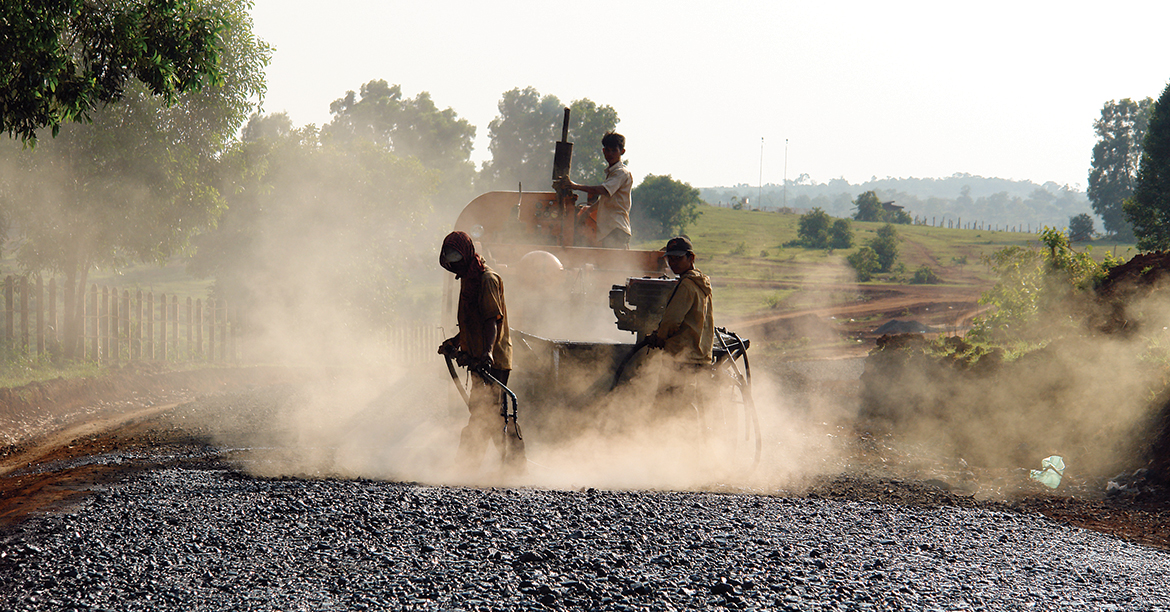
Workers build a road in Mondulkiri province. According to the Asian Development Bank, 15,400km of Cambodian roads are in need or repair. Photo: Stefan V. Jensen
One example of the expansive scale of this boom is the Chinese-backed Thai Boon Roong Twin Trade Centre. When completed, the towers are expected to extend 500 metres high, making them the tallest buildings in all of Southeast Asia. The project is slated to hold a shopping mall, office space, highend apartments and condominiums, six-star hotels and fine-dining restaurants. In addition to the $2.1 billion construction cost, the developers will invest an additional $3 billion in operating costs to ensure the success of the huge project once it is running.
The boom has also led to $100m of Chinese money being used to fund the Morodok Techo National Sports Complex. This will include the construction of a $157m football stadium 15km north of Phnom Penh, which will hold about 60,000 people upon completion in 2020. It’s a project that Cambodia’s Prime Minister Hun Sen has said will make a great contribution to developing the sports industry in the country.
Such projects are certainly creating a wealth of new jobs, especially in the capital. According to figures released by the MLMUPC, there are about 50,000 people employed each day in construction in Phnom Penh alone, plus an additional 23,000 casual workers. One such worker is Ry from Kampong Speu province, who asked to withhold his surname to protect his identity.
Ry explains that he was unable to get a job in his province as most of the roles available were factory positions that are normally only given to females. The construction industry, he admits, is hard work and workers are treated poorly, but for many young Cambodian men, it’s one of the few opportunities for steady employment and income.
The boom is being driven by massive foreign investment, in particular from China, which accounts for 70% of total industrial investment in the country, according to figures from Open Development Cambodia.
An artist’s rendering of the Bridge, a luxury 45-storey apartment complex currently under construction in Phnom Penh.
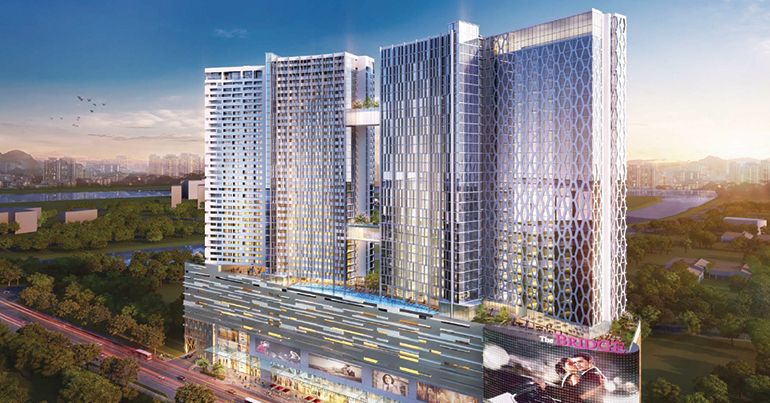
Ross Wheble, Cambodia country director of the UK-based real estate firm Knight Frank, points to the ‘friendship’ between Cambodia and China as a catalyst for the surge in investment. “With Cambodia and China having a special relationship, and [the former] being a belt-and-road country, we have some big Chinese companies looking to invest in Cambodia,” he explains.
Cambodia is an important piece of the geographical puzzle in Chinese Premier Xi Jinping’s ‘One Belt, One Road’ vision, which seeks to build roads, bridges, ports, pipelines and much other infrastructure to link up the ancient ‘Silk Road’ trading route that stretched from East to West.
From Cambodia’s perspective, the relationship with China is an attractive one; Hun Sen’s government is able to benefit from huge investment without the conditions imposed by donors such as the US or World Bank in terms of political transparency and human rights.
Yet, despite the mutual benefits, questions are being raised over whether the construction projects prioritised by these Chinese partnerships are genuinely addressing Cambodia’s most pressing needs.
Of particular concern is Phnom Penh’s housing crisis. Current estimates suggest that the capital’s population will grow by more than 50% by 2030, leading to a population of 7.9 million. According to government estimates, that will create the need for an additional 800,000 homes in the next 13 years. However, rather than build urgently needed affordable homes, the Chinese construction industry in Phnom Penh is largely focused on the luxury market.
“There is already an oversupply of the luxury condominium market in Phnom Penh, which is being driven by the foreign market,” says Wheble. “The mass market cannot afford these units.”
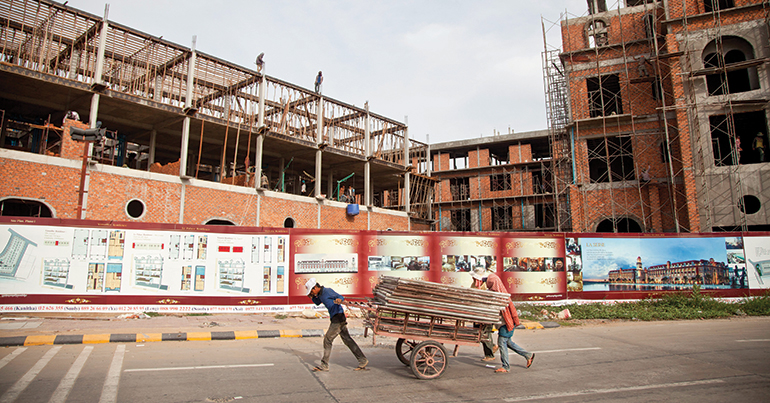
But it’s not only a question of price, it’s also one of cultural differences, according to Kimleang Kean, managing director of the real estate development firm Urban Living Solutions. He explains that the kinds of homes being built are out of sync with the tastes of the Cambodian market, which he says values a community feel rather than generic condos that alienate people from their neighbours. Kean, who grew up in a small shophouse in Phnom Penh, is adamant that the future of construction in Cambodia will be in building affordable homes that target the emerging middle class that will account for much of the city’s population boom.
“It’s the market. Targeting rich foreigners is no longer the game. Affordable housing is recession-proof. It won’t make you rich, but it’s a start,” says Kean, who is hoping that his Urban Village project, which focuses on community living, will be completed in the next five years.
Kean is not alone in focusing on housing that meets the needs and values of Cambodian buyers. Jerome Luciani-Khao, deputy general manager of LBL, a French-Cambodian construction firm that has operated in Cambodia since 1991, agrees that demand for affordable housing in Phnom Penh is growing and that others are stepping in to fill the gap left by many overseas developers. He says he is seeing a surge in investors interested in building homes worth $30,000-$50,000, as opposed to the usual price range of luxury condos, which come in at about $70,000-$100,000.
In addition to housing, Cambodia’s lack of infrastructure is a major stumbling block to development. In a speech given this year at Phnom Penh’s Royal University of Law and Economics, International Monetary Fund (IMF) deputy managing director Mitsuhiro Furusawa emphasised the importance of “building the infrastructure to support the next stage of development”, saying that this means “providing the skills needed to succeed in a modern economy. And it means giving all Cambodians a stake in the financial system”.
Again, Cambodia’s most pressing infrastructure requirements do not always seem to dovetail with China’s priorities. As Miguel Chanco, lead Asean analyst at the Economist Intelligence Unit, suggests, construction projects could often be better focused on the needs of the country.
“There is certainly a lot of grandstanding, especially with regards to Phnom Penh’s property market, but at the same time, Cambodia’s infrastructure needs remain substantial,” he says.

An interior shot of T Galleria by DFS, a luxury store built by French-Cambodian firm LBL Construction.
Often, the most valuable investments in large-scale infrastructure projects come from other quarters, such as the Japanese International Cooperation Agency (JICA). Deputy chief representative Kotaro Tanaka likens his organisation to a mix between the World Bank, Asian Development Bank and USAID, claiming that JICA is working on projects that will enable Cambodia to develop in the long term.
These include a $400m investment into the deep sea port in Sihanoukville and a number of cross-country infrastructure projects, such as the construction of better roads linking Phnom Penh to the Thai and Vietnamese borders.
Tanaka hopes that building these roads will in part help reduce road traffic accidents, which are one of the leading causes of death in the country, totalling 1,576 in 2016 according to the National Police Service website. The roads should also lead to a more effective logistical transport system, which has been dubbed the Southern Economic Corridor and should facilitate the transport of goods in and out of Cambodia with greater ease.
Despite such efforts, Tanaka believes that Japan, which was once Cambodia’s biggest donor and development partner, is now seen as of secondary importance to China. To illustrate the extent of his country’s past influence, he smooths out a Cambodian 500 riel banknote, pointing to depictions of two JICA-built bridges, one of which is flying a Japanese flag. In recent years, though, Japan’s influence has diminished. “China is number one,” says Tanaka. “We cannot keep up with the size, speed or volume [of Chinese projects].”
Japan and China, which Tanaka calls “natural partners and [at the] same time natural rivals”, rarely compete for the same projects, but they do appear to have competing visions for the country. According to Tanaka, China focuses on more ostentatious projects, often with little urban planning or forward thinking, whereas JICA is shifting towards smaller projects with a greater emphasis on technology and protecting the environment. “This is our differentiation,” he says.
Representatives from major Chinese developers and industry representatives, such as the Hong Kong-based Eastland Development, Sino Great Wall and the Chinese Ministry of Commerce in Cambodia did not respond to, or refused, requests for interviews.
Construction workers in Sen Monorom repair the road. Photo: Stefan V. Jensen
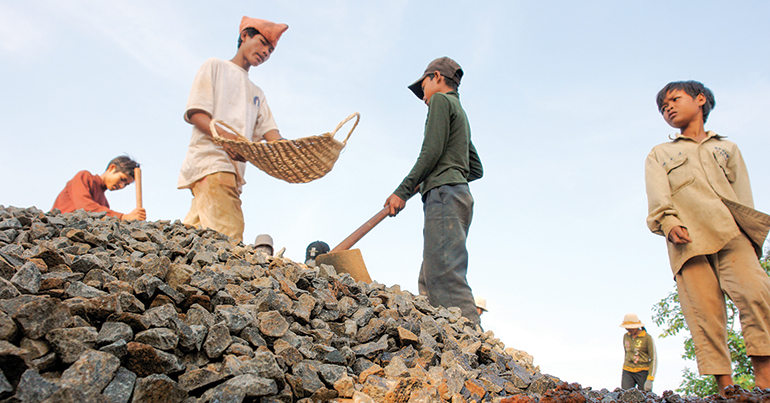
Tanaka is not the only onlooker who has raised serious concerns with many of China’s more ambitious initiatives in Cambodia.
Earlier this year, Sophal Ear, author of Aid Dependence in Cambodia: How Foreign Assistance Undermines Democracy, told the Cambodia Daily newspaper: “Who knows what, if any, environmental impact assessment there is before all this infrastructure goes up? With the World Bank and other Western donors there are more safeguards… Only a couple of years ago, a road the Chinese built went bad within months. Asked why, they said the dirt in Cambodia is different than in China.”
Meanwhile, the $800m Lower Sesan 2 Dam, in the northeast of the country, has been widely accused of being constructed with little thought given to local residents or the project’s environmental impact. An article in the Washington Post estimated that up to 5,000 people living in the surrounding area might need to be evicted when the reservoir of the dam fills, while 40,000 people who rely on the Sesan and Srepok rivers face losing both their food and livelihoods.
Despite persistent criticism of Chinese construction projects, on the other hand there is major concern about the economic impact and the potential massive loss of jobs should the investment from Cambodia’s largest benefactor dry up.
“When we speak about a boom we can speak also about a crash. It’s something that can happen,” says Luciani-Khao, although he is eager to stress his confidence in Cambodia’s economy to withstand fluctuations in investment.
Chanco is less optimistic, though, warning that Cambodia should be wary of a Chinese investment bubble. “Here at the EIU we expect economic growth in China to slow more markedly than in recent years after the party congress [in October], as the authorities there take more aggressive measures to tame what we see as unsustainable build-up in debt,” explains Chanco. These measures could also affect Chinese construction projects in Cambodia, he says.
Worse, while a Chinese investment bubble in the capital would result in a slew of empty, overpriced condos in a city desperate for affordable homes, Wheble believes that there is little evidence to suggest that the market would correct itself with a decline in house prices.
“There won’t necessarily be a decline in prices as these guys [Chinese investors] are cash buyers, so they will just hold onto it,” explains Wheble.
Others say they have already begun to see signs that China is putting the brakes on their construction drive. “You can see the projects are slowing down,” says Kean. “Now they are taking their time. They are not stopping, which is good, but they are slowing down.”


